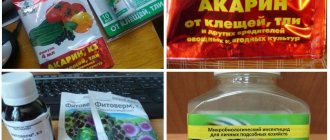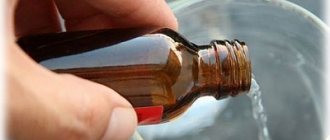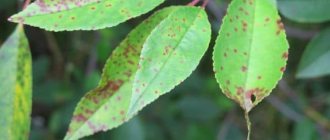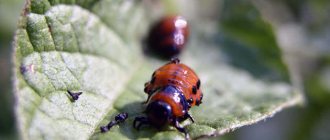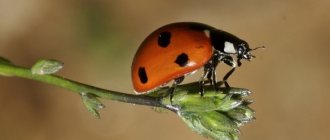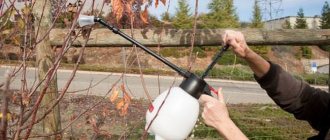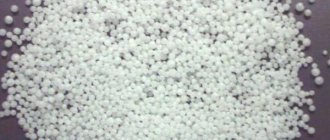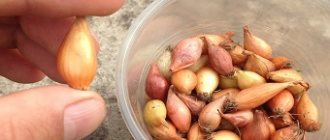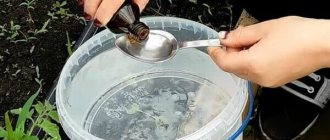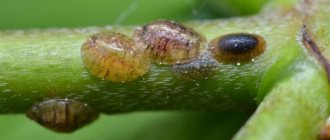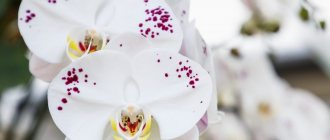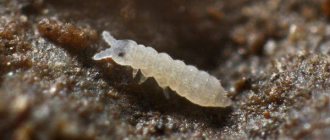If you could not find your drug by name in the proposed material, determine its main Active Ingredient (usually it is written on the packaging) and read about the properties of other drugs based on this active ingredient. All preparations made on the basis of the same active substance have in practice the same effect on the plant.
Many insecticides are toxic drugs, and the advisability of their use at home must be justified. We kindly ask you to read the safety rules when working with toxic substances before using drugs.
Insecticides (from the Latin insectum - insect and caedo - kill) are chemical preparations from the group of pesticides for the destruction of insects - plant pests, their eggs (ovicides) and larvae (larvicides). Insecticides are also used to combat insects that carry diseases and ectoparasites of animals, household insects, and to protect food supplies, fabrics and other materials.
Based on the nature of penetration of insect pests into the body, insecticides are divided into three groups (it should be taken into account that most of them “use” several routes simultaneously). So:
- Contact insecticides kill harmful insects upon external contact with any part of their body. They protect only those parts of the plant to which they are applied, are highly dependent on precipitation and have only a protective effect.
- Intestinal insecticides - penetrate the insect’s intestines through the nutritional organs and infect with poison, which is absorbed into its body.
- Systemic insecticides are able to move through the vascular system of plants. Their damaging effect occurs when insects use poisoned parts of the plant for food. In this sense, systemic insecticides are close to intestinal ones. They are quickly absorbed by the plant, and therefore their effectiveness is not strongly dependent on rainfall.
Some insecticides cause blockage of the insect's respiratory tract, as a result of which it dies from asphyxia.
Continuous action insecticides are used to control various types of insect pests simultaneously.
Selective insecticides are used only against a specific type of pest. Such insecticides include:
Anthelmintics are chemicals used to control parasitic worms on plants and animals.
Nematicides are chemicals used to control nematode roundworms.
Acaricides are chemicals used to control ticks. There are two groups of acaricides:
- specific acaricides , which act only on ticks and are inactive against other arthropods;
- insectoacaricides , acting not only on ticks, but also on other insects.
Among the acaricides there are many drugs with selective action. There are drugs that are active against herbivorous ticks and are practically safe for ixodid ticks, which insectoacaricides will help defeat.
Please note: With the systematic use of insecticides of one group, so-called resistance in pests inevitably arises. This term usually refers to the resistance of various organisms to certain chemicals. This resistance is especially often observed in rapidly reproducing species that have a very short development cycle. To prevent the emergence of resistance, it is necessary to alternate insecticides from different groups. Therefore, if a pest appears in the collection that cannot be removed with a suitable means, it is worth trying to use an insecticide used against the same pest, but from a different group.
Currently, instead of chemicals, similar preparations of plant or organic origin (bacterial, viral, etc.) are being developed, which are not inferior in their effectiveness to chemical ones, but, as a rule, affect only a certain group of pests and are safe for other types of insects and warm-blooded animals , including humans.
Content
- 1. Avermectins
- 3. Viral insecticides
- 4. Insecticides—chitin synthesis inhibitors (CHS)
- 5. Insecticides - carbamates
- 6. Mineral oils - insecticides
- 7. Neurotoxins - insecticides
- 8. Neonicotinoids
- 9. Inorganic substances - insecticides
- 10. Pyrethroids/pyrethrins
- 11. Plant insecticides
- 12. Phenylpyrazoles
- 13. Insecticides - organophosphorus compounds (OP)
- 14. Insecticides - organochlorine compounds (OCCs)
- 15. Entomopathogenic nematodes
- 16. Juvenoids
- 17. Other insecticides
The material “General Classification of Insecticides” gave general concepts - what insecticides are, how they first appeared and developed, how they are classified (by composition, by purpose, by method of application, by mechanism of action, by method of penetration into the pest’s body, etc.)
How to understand the variety of drugs produced?
Chemical classification of insecticides (by groups/classes and active substance/composition) is the basis for the systematization of insecticides.
In this material we will consider the main groups of insecticides, their active ingredients and main characteristic features. We also structure the most common and practically used drugs - insecticides - according to their composition, which determines the mechanism of their action and the scope of their practical application.
Currently, there are 17 groups of insecticides, fundamentally different in composition:
- Avermectins;
- Bacterial insecticides;
- Insect viruses;
- Chitin synthesis inhibitors;
- Carbamates;
- Mineral oils;
- Neurotoxins;
- Neonicotinoids;
- Inorganic substances;
- Pyrethroids;
- Plant insecticides;
- Phenylpyrazoles;
- Organophosphorus compounds;
- Organochlorine compounds;
- Entomopathogenic nematodes;
- Juvenoids;
- Other substances
Hazard classes of insecticides
In order to obtain environmentally friendly and healthy vegetables and fruits, as well as not to harm the fauna, it is extremely important to pay attention to the hazard class of insecticides:
Hazard class 1 drugs are extremely toxic, so they are used only in enclosed spaces. To avoid accidents, people's access to such premises should be limited until ventilation is completed. Typically, class 1 insecticides include fumigants.
Drugs of hazard class 2 also have a high degree of danger. Therefore, their use for processing feed crops is prohibited.
Hazard class 3 drugs are moderately dangerous. These include a variety of granules, emulsions, as well as insect crayons, tablets against moths and mosquitoes. This class of insecticides is characterized by low toxicity for mammals and birds, but is extremely dangerous for cold-blooded animals, including fish and reptiles.
Preparations of hazard class 4 have low toxicity and are usually destroyed within a week after use, so they are convenient for treating fruit trees and vegetable beds. These drugs are considered both chemical and biological insecticides, due to the fact that their action is based on the natural neurotoxin avermectin.
When using insecticides, it is extremely important to carefully read the instructions, since certain drugs belonging to hazard classes 1-3 can be very toxic to certain species of fauna.
Avermectins
Avermectins are waste products of the fungi Streptomyces avermitilis. The toxic substances of this group of insecticides are difficult to attribute only to chemical or only to biological compounds. The mechanism of action is neurotoxin type. The method of penetration is contact-intestinal. They have a non-macidal effect. They work well at elevated temperatures, although they are unstable compounds.
| Abamectin |
|
| Aversectin S | "Fitoverm, KE/P", "Kleschevit, KE" |
| Avertin N | "Akarin, KE" |
| Emamectin benzoate | "Proclaim, VRG" |
Bacterial insecticides
Bacterial insecticides are derived from bacterial pathogens. 90% of drugs are currently based on the entomopathogenic bacterium Bacillus thuringiensis. They are highly specific and act only on insect larvae. The speed of initial impact is not high. Affects the generation of pests and the appearance of non-viable offspring. There is no resistance. The lack of phytotoxicity allows the preparations to be used at any phase of plant development. These are new generation drugs with minimal impact on the environment.
| Bacillus thuringiensis | "Bitoxibacillin, P", "Lepidobactotsid, F/P/SK", "Baktsid, P", "Biostop, F" |
| Bacillus thuringiensis var. kurstaki | "Lepidotsid, SK/P" |
| Bacillus thuringiensis var. thuringiensis | "Bitoxibacillin, P" |
| Polypeptide |
Types of insecticides
Based on their effect on unwanted insects, drugs are grouped into several main groups:
Popular types of insecticides
- Contact - affects the insect through direct contact.
- Intestinal - enter the insect’s digestive system and destroy it from the inside.
- Systemic insecticides of contact-intestinal action are a universal group that affects insects through contact with the digestive system.
- Fumigants act through the respiratory organs, leading to the death of the insect. They have a gaseous state.
- Biological - the basis for their creation are various bioactive substances (fungal spores, microorganisms).
- Insecticides of systemic action - penetrate and accumulate in all parts of the plant (green mass, fruits) destroying the insects living inside and gnawing the outer shell.
You can also read the article “Aphids: control methods”
Description of systemic insecticide for plants
The drugs are used to protect crops from sucking insects and mites. The first compositions appeared at the beginning of the 20th century and became widespread among agronomists and gardeners who tend large areas of garden plantings. Over time, the group of drugs has expanded significantly. Now it includes a large number of chemical and biological systemic insecticides.
Pests of garden plants
Action: penetrating deep into the culture, the composition affects parasites. The active substances of the drugs suppress the vital functions of the insect, leading to its death. Most compounds act on the nervous system, causing paralysis. Certain types of drugs have an inhibitory effect on hormonal activity and reproductive functions. Thanks to this, the products provide reliable protection for a long time.
Systemic insecticides are most effective against insects, mites, aphids, and other types of parasites.
Universal compounds have a detrimental effect on almost all types of pests. There are narrow-spectrum products specifically designed to eliminate a specific type of parasite:
- Acaricides – drugs to combat ticks;
- Ovicides - act on laid eggs of insects and mites;
- Larvicides - help in exterminating caterpillars and various parasite larvae;
- Insectoacaricides – affect a wide range of insects and mites;
- Aphicides are aimed at combating aphids.
Application of systemic insecticides for fruit trees
Systemic insecticides for the garden are available in various forms: granules, sprays, powders, liquids. Depending on the composition, plants are processed in different ways:
Spraying insecticides on fruit crops in the garden
- They are introduced into the ground. Designed to protect vegetable crops.
- Dust and spray the crop. Used to protect fruit trees, shrubs, vegetables, and berry bushes.
- Insect baits. It is spread out in small quantities and acts as a bait for pests.
You may be interested in the article “Spider mites: how to deal with the pest”
List of drugs by toxicity
All chemical compounds have a certain level of toxicity, which must be taken into account when purchasing and using them. Not only the harvest, but also human health and the state of the environment depend on this. There are several classes of toxicity:
- The first is a very toxic substance. There is limited access to such substances and use at home is prohibited.
- The second is a high degree of toxicity and danger. Application in plant processing is extremely limited.
- The third one has a moderate level of toxicity. Relevant in the fight against parasites, safe for mammals, harmful to cold-blooded reptiles.
- Fourth – low level of toxicity. Preparations of this type are used in gardening and vegetable growing to protect plants.
When choosing a garden treatment product, carefully read the instructions and do not purchase products belonging to the first or third group.
Viral insecticides
Viral insecticides contain viruses that cause insect diseases as active ingredients. The main task of this group is to reduce the number of pests, not to destroy them. Viruses are the simplest non-cellular life forms that parasitize host cells using a molecular genetic apparatus. Getting into insect tissue through the intestines, they cause serious metabolic disorders in cells.
| Cydia pomonella granulovirus | "Madex Twin, SK" |
| Codling moth granulosis virus | "Carpovirusin, SK", "Madex Twin, SK", "FermoVirin YAP, SP" |
| Cotton bollworm nuclear polyhedrosis virus | "Helikovex, SK" |
Danitol
Danitol, 10% K.E. Used for spraying pome trees in a concentration of 10 ml per 10 l of water at the end of flowering (when 75% of the petals fall) against a complex of pests (leaf rollers, moths, aphids, scale insects and false scale insects, apple sawfly , fruit weevils); 18-20 days after the end of flowering of winter apple trees - against the codling moth, against scale insects - 30 days before harvest.
Insecticides—chitin synthesis inhibitors (CHIs)
This group of insecticides causes the death of insects by blocking the formation of chitin. Disturbances in the synthesis of chitin in the body of the larval stages lead to their death and the formation of malformed, non-viable forms. In the 60s, a hormone that regulates the molting of insects, ecdysone, was discovered, and then its analogue, ecdysterone.
Currently, one of the promising ones for use is diflubenzuron . The active substance penetrates through eggshells, preventing the larvae from emerging from the eggs or destroying the larvae of mining insects that penetrate into the leaf tissue directly under the egg shell. The drugs have a sterilizing effect. Quick impact. Selectivity. The effectiveness of treatments depends on the timing of application.
| Buprofezin | "Apploud, SP" |
| Diflubenzuron | “Herold, VSK”, “Dimilin, SP/VDG”, “Diflutsid, SP” |
| Lufenuron | "Match, CE" |
| Triflumuron | "Baicidal VP 25, VRP" |
| Cyromazine | "Neporex, VRG/VRP" |
Rescue for indoor plants
The use of insecticides for home crops and potted flowers has some nuances. Pest control in such conditions can be no less intense, differing only in the size of the field of activity. Here the issue of human safety is especially acute, since indoor flowers grow directly in his home.
Applicable:
- acaricides - against ticks;
- aphicides that help fight aphids;
- insectoacaricides - from various insects;
- ovicides – against parasites found in laid eggs;
- larvicides – against pests in the larval stage.
Here are some of the main types of domestic flower parasites and options for combating them:
- thrips - found on ficus and violets. To combat, treatment with systemic drugs in combination with contact drugs is required;
- weevil - attacks figs, tolmia, intestinal remedies are effective;
- spider mite - damages balsams, callistemons, orchids. Most suitable for general exposure;
- whitefly - often attacks roses. All suitable formulations for processing are recommended;
- root-knot nematodes - affect chrysanthemum, nephrolepis, chlorophytum. Systemic means of control are suitable.
- Scale insects, false scale insects - affect begonias, calamondina, aloe. Mealybugs attack yucca and myrtle. Contact insecticides are ineffective; effective agents that affect the digestive system are used.
To combat scale insects, scale insects, and scale insects, damaged plants are wiped with water-oil mixtures, alcohol, and surface soil is replaced. Afterwards, spraying is carried out with Aktarav in the form of a solution - 4 g per 5 liters of water, watering the soil with a composition of 1 g per 10 liters. Cultivation is repeated 4 steps every 8-9 days. In parallel, you can treat with a 1% solution of Fitoverm - 4 times with pauses of 7 days. The auxiliary procedure is carried out every 48 hours with the following drugs:
- Agravertine;
- Metaphos;
- Akarin;
- Karate;
- Detis;
- Iskra-Bio;
- Inta-Vir.
To defeat thrips, yellow and blue sticky traps are attached around the crop. You need to treat all the flowers in the house, but for some you won’t be able to get the desired result right away. Spraying with Aktara is required - a solution of 4 g per 4-5 liters, watering the soil with 1 g per 8 liters 4 times with an interval of 7-9 days. Additional processing:
- Akarin;
- Karbafos;
- Iskra-Bio - 8 g of the drug per 9-10 liters of water;
- Fitoverm - 1% composition, spray 4 times, observing an interval of 8-10 days;
- Mospilan.
Measures against weevils: manual collection of pests, spraying with Aktara - 4 g per 5-6 liters, spilling soil - 1 g per 8-10 liters, repeat treatment 4 times after 8-10 days. Additionally, wipe the leaves with alcohol, use water-oil emulsions, and preparations:
- Apache;
- Kinmiks;
- Fifanon Nova;
- Bona forte;
- Actellik.
Hand picking, washing the leaves in the shower, spraying with any acaricidal compounds, and irradiating with an ultraviolet lamp for preventive purposes helps against spider mites. In closed ground conditions use:
- Vertimek;
- Neoron;
- Agravertine;
- Envidor;
- Kleschevitis;
- Dursban;
- Sunmite;
- Borneo.
Usually 4 times of treatment are required every 7-9 days, since the larvae can emerge from eggs in about 7 days. But the higher the air temperature, the more often.
The fight against whiteflies: yellow and blue sticky traps are left on a sunny glassed-in balcony in the heat. At low humidity, parasites die from overheating. Spraying green parts, spilling soil with means from the list:
- Aktara;
- Admiral;
- Iskra-Bio;
- Fitoverm;
- Comfidor;
- Inta-Vir;
- Kinmiks;
- Talstar.
Removing damaged roots, washing in hot water, adding Fitoverma, Agravertina in powder form to the soil mixture, and treating with the anti-stress agent Ecogel helps against damage by root-knot nematodes. It is recommended to spray with poisons such as:
- Rogor;
- BI-58;
- Dimethoate;
- Ruskamin.
The biological product Nematophagin-BT based on a predatory fungus is often used. When processing indoor flowers, it is best to take them out onto the balcony or into the bathroom, spray them, wipe them with the required composition as quickly as possible, then wash your hands, face, rinse your mouth, and change clothes.
Insecticides - carbamates
Carbamates are esters of carbamic acid. They play a special role in plant protection, since they are able to enter plants from soil and treated seeds, move well to above-ground organs and protect seedlings for a long time (6-10 weeks). However, preparations based on them are characterized by high toxicity for warm-blooded animals and humans. Often used against synanthropic insects. Carbamates are not only the basis of insecticides, but also fungicides and herbicides.
| Bendiocarb | "Fikam, SP" |
| Carbosulfan | |
| Carbofuran | "Khinufur, KS" |
| Methomyl | "Lannat, SP", "Karakurt, P", "Muskachid, G" |
| Propoxur | "Effective Ultra, ISS" |
List of effective insecticides for the garden
There are quite a large number of drugs; we will dwell on some of them in detail. They have proven themselves to be the most effective and universal in protecting garden plantings:
- Commander is a systemic insecticide against aphids, flea beetles, and other parasites, composition of the contact-intestinal group. It is used for processing vegetable plantings and fruit trees. The spectrum of action is wide. Affects sucking pests. Treatment is carried out during the growing season of the plant. It has a high level of efficiency. For a good result, one treatment of the plant is enough. Low toxicity for people and the environment. Destroys insects by acting on their nervous system. The drug is sprayed evenly over the plant and is not used during the flowering period.
- Bi 58 systemic insecticide, against mites, caterpillars, leaf-eating insects, aphids, apple flower beetles, codling moths, and other parasites. It works in several directions at once: long-term, systematic, contact. Evenly distributed inside the plant, it provides long-term protection (about three weeks) from all sucking types of parasites. The active substance is phosphoric acid ester. Not phytotoxic. Sold in the form of a concentrated emulsion. Thanks to its universal formula, it has a wide spectrum of action and is used for fruit trees and vegetable crops. Also, a systemic insecticide is used to protect roses from aphids and other garden and ornamental crops.
- Calypso is a systemic insecticide for coniferous trees, ornamental plants, vegetables, fruit trees, and berry bushes. Effective against a large number of parasites: aphids, codling moths, fruit moths, weevils, flea beetles. Non-toxic, has a long period of action (about a month). Used during the growing season of the plant. For safety reasons, the last treatment with the drug is carried out a month before the start of harvesting. Sold as a ready-to-use liquid, in containers of varying volumes.
The given list of systemic insecticides for the garden is made up of universal preparations that have minimal toxicity and are safe for humans and nature.
Mineral oils - insecticides
The active ingredients of insecticides are products of the distillation of petroleum, coal and brown coal, wood tar, etc. But most often they are made on the basis of petroleum oils. The preparations are highly toxic to scale insects, false scale insects, scale insects and mites. However, they are characterized by a short protective period and are most often used for earlier spring treatments.
| Mineral/Vaseline oil | “Preparation 30 Plus, MME”, “Profilaktin Light, VE”, “Profilaktin, MKE” |
Sumi alpha
Sumi-alpha, 5% E. Pyrethroid drug. Toxic to many sucking and chewing pests. Recommended for spraying pome fruits (apple, pear, quince), grapes and cruciferous crops (cabbage, radish, radish) at a concentration of 5 g per 10 liters of water. The drug is sprayed once. Waiting period - 30 days (grapes - 45 days). Pome crops are sprayed against the apple flower beetle (during the green cone phase), leaf rollers, moths, aphids, scale insects, apple sawfly, goose, codling moth, California scale insect (after flowering).
On grapes, the drug is used during the separation of buds in inflorescences against grape budworm and grape moth. On cabbage and other cruciferous vegetables, the drug is used before the head is planted to destroy cruciferous flea beetles, cabbage moths, armyworms, aphids, flies, whiteflies, sawflies, and bedbugs. Potatoes are sprayed against the Colorado potato beetle in the same concentration no more than twice. The waiting period is 20 days. The drug is toxic to both beetles and larvae.
Neonicotinoids
Neonicotinoids are nitromethylene heterocyclic compounds (artificial nicotine). The drugs are characterized by systemic action and high selective activity. One of the main groups of insecticides used today to combat sucking and leaf-eating insects (aphids, whiteflies, Colorado potato beetles, weevils, leafhoppers), as well as soil-dwelling pests (click beetles).
Mechanism of action: the transmission of nerve impulses is blocked, and the insects die from nervous overexcitation. The drugs are not phytotoxic, but have systemic properties.
| Acetamiprid | "Agent, VDG", "Alfa-Amiprid, RP", "Gazelle, RP", "Mospilan, RP", "Snake, RP", "Stozhar, RP" |
| Imidacloprid | “Akiba, VSK”, “Biotlin Bau, VR”, “Biotlin, VRK”, “Warrant, VRK”, “Zhukoed, SK”, “Zhukobor Extra” “Zaman, VRK”, “Zubr, VRK”, “Imidor Pro” , KS", "Imidor, VR", "Iskra Zolotaya, VRK/P, Tab", "Kalash, VRK", "Klubneshiet, KS", "Commander Maxi, VDG", "Commander, VRK", "Konfidelin Super, VDG", "Konfidelin, VRK", "Confidor Extra, VDG", "Corado Light, KS", "Corado, VRK", "Colorado, VRK", "Kortlis, VRK", "Movento Energy, KS", "Monsoon , VRK", "Pinotsid, SK", "Patron, KS", "Prestige, KS", "Prestigator, KS", "Discharge, G", "Rembek, G", "Respect, KS", "Rofatox, G ", "Rubezh, G", Tabu, VSK", "Tanrek, VRK", "Tsvetolyuks Bau, VR" |
| Clothianidin | “Bushido, VDG”, “Borey Neo, SK”, “Delight, KS”, “Gladiator Super, KS”, “Doctor, Tab”, “Zhukoed, SK”, “Insector, KS”, “Punisher, VDG”, “Clonrin, CE”, “Clotiamet, VDG”, “Modesto, KS”, “Pinotsid, SK”, “Poncho, KS”, “Tabu Neo, SK”, “Tayshin, VDG” |
| Thiacloprid | “Aspid, SK”, “Biskaya, MD”, “Calypso, KS”, “Pondus, KS”, “Proteus, MD”, “Theia, KS” |
| Thiamethoxam | "Aktara, VDG/KS", "Instivo, KS", "Kaiser, KS", "Cruiser, KS", "Kungfu Super, KS", "Pantsir, KS", "Celest Max, KS", "Celest Top, KS", "Tiara, KS", "Force Zea, KS", "Harita, KS", "Chansomethox Trio, KS", "Ephoria, KS" |
How our ancestors fought pests
Insecticides are chemicals that are used to treat plants to kill or repel insect pests and their offspring. The name insecticide is derived from two Latin words: insectum - insect, caedo - to kill.
The first mention of treating plants with certain substances to protect them from harmful insects dates back to Ancient Egypt. There, the dried inflorescences of Persian chamomile (pyrethrum) were crushed into powder and treated with it on the plants. Aristotle recommended the use of sulfur in the fight against harmful insects. In the army of Alexander the Great they used similar powders to fight lice. In the Middle Ages, alchemists prepared tinctures from poisonous plants for these purposes. The Chinese used tobacco tincture to control pests.
Insecticides are designed to kill insects
But insect repellents were widely used only in the middle of the 19th century. In 1867, Paris green (mixed copper acetate-arsenite) was used successfully against the Colorado potato beetle for the first time. It and other arsenic compounds were used in the fight against various pests until the 60s of the 20th century in many countries. Since 1896, they began to use kerosene-lime and kerosene-soap emulsions, substances of plant origin - nicotine sulfate and anabasine sulfate. At the very beginning of the 20th century, an emulsion of petroleum mineral oils began to be used to combat sucking pests.
In this video you will learn about the insecticide “Karate Zeon”: In the 20th century, scientific research in the field of chemistry was actively carried out, as a result of which many hitherto unknown chemical compounds were discovered. Some of them had insecticidal properties. Similar properties have been found in some compounds discovered or synthesized earlier. In 1939, a group of German chemists discovered the insecticidal properties of dichlorodiphenyltrichloroethane (DDT). In 1942, a patent was received for the use of DDT as an insecticide. In the same year, while studying a group of chlorine-containing compounds, chemists were able to identify the same properties in hexachlorocyclohexane (HCCH) and landan.
In the early 40s, German scientists synthesized organophosphorus compounds with significant insecticidal activity, and in 1949 the first pyrethroid was synthesized for the first time. Research in the field of chemistry continues to bring new discoveries to this day, adding to the list of insecticides.
It is necessary to carefully treat the area against insects
Inorganic substances - insecticides
This is a large group of pesticides that use inorganic compounds as active ingredients. They work as insecticides, acaricides and fumigants. They are used to protect stocks from pests, also for sanitary and household disinfestation and in veterinary medicine.
| Boric acid | “Dohlox, Boric gel/Boric traps”, “Baf, dust”, “Bifetrin, P”, “Anteater-ECO” |
| Methyl bromide/ Methyl bromide | |
| Sodium tetraborate/borax | "Antiant, P" |
| Sulfur | "Vitashans, VDG", "Cumulus DF, VDG", "Tiovit Jet, VDG" |
| Aluminum phosphide | “Alfin, Tab”, “Dakfosal, Tab”, “Ginn, Tab”, “Katfos, Tab”, “Quikfos, Tab”, “Foscom, Tab”, “Phostoxin, Tab”, “Phosphine, Tab” |
| Magnesium phosphide | "Magna, Tab", "Magnicum, Tab", "Magnifos, Tab", "Magtoxin, Tab" |
| Zinc phosphide | "Ratox, P", "Commando, P |
| Phosphine | "Alfin, Tab", "Dakfosal, Tab", "Genie, Tab", "Katfos, Tab", "Phosfin, Tab", "Fumifast, Tab", "Fumifos, Tab" |
Danger of pesticides for humans and the environment
It is quite obvious that substances that have a detrimental effect on various organisms cannot be completely safe for humans and nature. In the case of pesticides, this is true. Of course, the greatest danger of these chemicals is that they are used to treat fields and orchards, the fruits of which then go on sale, and then on to our table. Even after thorough washing and heat treatment, it is not possible to get rid of all chemical residues. Therefore, in the end, a person becomes another object of exposure to pesticides.
As for household chemicals that contain these components, they are especially dangerous. This is due to the fact that while cleaning the bathtub or spraying cockroach repellent, you come into direct contact with the substance. This means that it easily reaches your skin, mucous membranes and further into the body. In addition, residues of the product remain for a long time on surfaces that you and your family members, such as children, touch.
By using household chemicals containing pesticides, you and your family risk:
- get poisoned and have digestive system disorders;
- develop an allergy, which in some cases can develop into a systemic disease of the respiratory system.
In addition, frequent contact with pesticides can cause the development of a number of diseases of the nervous system. In this case, children and pregnant women are at risk. For this category of the population, any contact with pesticides is completely prohibited.
We should not forget about the negative impact of pesticides on nature. By spraying poisons, you risk destroying not only harmful microorganisms, but also beneficial bacteria, or even insects that do not cause any harm to you and the environment. If you have pets at home, they can also suffer from such household chemicals. Once they eat tasty food from a floor treated with an aggressive chemical disinfectant, you will soon have to look for a cure for the poisoning.
Pyrethroids/pyrethrins
Natural pyrethroids (pyrethrins) are found in the flowers of pyrethrum (Dalmatian chamomile), their analogues are artificially created synthetic pyrethroids.
A large group of preparations based on them is used to control pests of fruit and vegetable crops, stock pests, to treat farm animals against ectoparasites, soil pests, synanthropic pests, etc. An effective fumigant. Has selectivity. The preparations are not phytotoxic. Long-term use of pyrethroids causes resistance.
| Alpha-cypermethrin | “Ivanhoe, CE”, “Alterr, CE”, “Adamant, gel”, “Alpha Ring, CE”, “Alfa-Cypi, CE”, “Acaritox, SP”, “Alfatrin, SP”, “Alfacin, CE” , “Alfabel, CE”, “Alfaplane, KS”, “Alphas, CE”, “Alfatsin, CE”, “Armin, CE”, “Atrix, CE”, “Alfashance, CE”, “Baf, dust”, “ Biface, KS", "Borey Neo, SK", "Duplet, KE", "Zhukoed, SK", "Image Plus, KE", "Neofral, KE", "Piket, KE", "Pinotsid, SK", " Fatrin, KE", "Fastak, KE", "Forssythe, gel", "Bassoon, KE", "Fendona, KS", "Ci-Alpha, KE", "Tsunami, KE", "Zeppelin, KE", " Tsunami, KE", "Espero, KS" |
| Allethrin | |
| Beta-cypermethrin | "Kinmiks, KE", "Kinfos, KE" |
| Beta-cyfluthrin | "Modesto, KS", "Poncho Beta, KS", "Tibor, CE", "Solfak, ME |
| Bifenthrin | “Vulcan, TPS”, “Zernospas, KE”, “Imidalit, TPS”, “Clipper, KE”, “Pirinex Super, KE”, “Prokrop, KE”, “Semaphore, TPS”, “Talstar, KE” |
| Vaportrin | |
| Gamma-cyhalothrin | "Vantex, MKS", "Biorin, VKE", "Bifetrin, P", "Danadim Power, KE", "Nexid, MKS" |
| Deltamethrin | “Atom, CE”, “Decis Profi, VDG”, “Decis Expert, CE”, “K-Obiol, CE”, “Mittox-antimol, ZhK”, “Proteus, MD”, “FAS, Tab” |
| Zeta-cypermethrin | "Clonrin, KE", "Newstar, KE", "Taran, VE", "Fury, VE", "Taran, VE", "FAS-Super, VRP" |
| Lambda-cyhalothrin | “Ampligo, ISS”, “Delight, KS”, “Gideon, CE”, “Gladiator CE”, “Imidashance Plus, SK”, “Kaizo, VG”, “Canner Duo, KS”, “Karatoshans, CE”, “ Karachar, KE", "Kungfu Super, KE", "Lamdex, KE", "Lightning, KE", "Ephoria, KS", "Dr.Klaus - a remedy for ants and cockroaches", "Paragraph, VKE", "Alcot , G" |
| Permethrin | “Iskra, SP/Tab”, “Medilis-antiKLOP, Zh”, “Medifox-Super, CE” |
| Prallethrin | |
| Tau-fluvalinate | "Mavrik, VE" |
| Tetramethrin | "Medilis-antiKLOP, Zh", "Tetracin, CE", "Effective Ultra, MKS" |
| Tefluthrin | "Tefluthrin, ISS", "Force Zea, KS" |
| Cypermethrin | "Arrivo, KE", "Alatar, KE", "Biotsifen, dust", "Vega, KE", "Valley, KE", "Inta-Vir, Tab", "Iskra, SP", "Karbotsin, TAB", “Molniya Extra, CE”, “Medilis-antiKLOP, Zh”, “Medilis-CIPER, CE”, “Sipaz-Super, CE”, “Sichlor, CE”, “Tetracin, CE”, “Nurbel, CE”, “ Nurimet Extra, CE", "Rangoli-Noril, CE", "Superkill, CE", "FAS, gel", "Cyclone, CE", "Tsipi, CE", "Cirax, CE", "Citox, CE", “Shaman, CE”, “Shar Pei, ME”, “Cypermethrin, CE”, “Tsipromal, CE”, “Ciradon, VKE”, “Extermin-C, MKK”, “Ectometrin, CE”, “Ectometrin, CE” |
| Esfenvalerate | "Sumi-alpha, KE" |
Bacterial insecticidal compounds
Biological insecticides are used in the prevention and control of parasitic insects along with pesticides. These are environmentally friendly drugs based on various viruses and bacteria. A slow inhibitory effect on pests is observed immediately after treatment. These compositions are completely non-toxic, do not pose a danger to people, and will not damage the plant.
The most common:
- Fitoverm is a bacterial insecticide used against various insect pests and is well compatible with other chemicals and growth regulators. Effectively deals with mites and sawflies. Treatment during flowering is prohibited.
- Iskra-Bio - kills most known pests, including ticks. It is most effective in sunny, dry weather. The composition is safe, because this method of processing is possible 1-3 days before harvesting berries, vegetables, and fruits.
- Tobacco dust is the most popular among biological agents used for preventive work and control. It is used on flower, berry, and fruit plants in the form of decoctions, infusions, and pollination of these crops.
The main advantage of biological products is complete safety for humans, crops, and environmental friendliness. Only its effect is not rapid, therefore in cases of severe infection it is alternated with various pesticides.
Acaricidal drugs
Acaricides are aimed at preventive measures and the extermination of ticks. They are divided into the following groups:
- insectoacaricides are pesticides that have a detrimental effect on small individuals and some other insects. They are used relatively often, the most popular are Vertimek, Actellik, Neoron (the latter has an ovicidal effect);
- specialized ones - they exclusively exterminate ticks, and do not affect the rest at all. The most commonly used drugs are Omite, Apollo, Nissoran, Sunmite.
The above-described products are used for garden crops, indoor flowers growing in flowerpots, only in case of excessive mite infestation, which is difficult to exterminate.
Phenylpyrazoles
Phenylpyrazoles are a new class of insecticides developed for pest populations resistant to other drugs (OPS, carbamates, peretroids), such as locusts, Colorado potato beetles, cockroaches, etc. The drugs are characterized by long-term insecticidal toxicity.
| Pinoxaden | "Axial 50, CE", "Axial, CE", "Traxos, CE" |
| Fipronil | "Aria, KS", "Monarch, VDG", "Regent, VDG", "Taboo Super, SK", "Anti-cockroach gel", "Crossbow Neo", "Magic drops, gel", "Fumitox, gel" |
Bankol
Bankol, 50% SP. It is used against the Colorado potato beetle on potatoes by spraying the plants with a solution: 4-6 g per 10 liters of water. Spraying time: immediately after overwintered beetles appear on potatoes, when larvae appear in spring, in summer against beetles and larvae of a new generation. Treatment with the drug can be carried out no more than two times. The last treatment is no later than 20 days before harvesting. Peppers, tomatoes, eggplants are sprayed with a solution of the same strength as for potatoes against the Colorado potato beetle, gnawing caterpillars and cotton bollworm. The maximum number of sprayers is two, the last one is 40 days before the start of the first harvest.
Insecticides - organophosphorus compounds (OP)
Organophosphorus compounds are substances derived from pentavalent phosphorus that have similar mechanisms of action on insect pests. They have a systemic effect. They decompose quickly in the soil (except for chlorpyrifos). The drugs are characterized by a wide spectrum of action on harmful arthropods (except for Diazinon).
Introduced into circulation since 1965 to replace DDT, hexachlorane and other organochlorine compounds. FOS turned out to be easy to synthesize and highly effective against insects; they are actively used to this day.
| Azamethiophos | |
| Diazinon | “Diazinon-600, CE”, “Diazol, CE”, “Sharp 600, CE”, “Praktik, CE”, “Ricochet, CE”, “Enlil, CE”, “Barguzin, G CE”, “Vallar, G ", "Grizzly, G", "Thunder, G", "Thunder-2, G", "Zemlin, G", "Medvegon, G", "Medvetox, G", "Anteater, KE", "Muravyin, G ", "Provotox, G", "Terradox, G", "Trap-assault, gel", "FAS, gel" |
| Dimethoate | “Alpha-Director, CE”, “Bi-58 NEW/TOP, CE”, “Binadin, CE”, “Bishka, CE”, “Danadim, CE”, “Di-68, CE”, “Dimetron, CE” , "Dimetus, CE", "Dimephos, CE", "Dishance, CE", "Rangoli-Duncan, CE", "Rogor-S, CE", "Sirocco, CE", "Tagore, CE", "Tibor, KE", "Tod, KE", "Fostran, KE |
| Dichlorvos (DDVP) | |
| Malathion | “Aliot, KE”, “Alatar, KE”, “Antiklesch, KE”, “Bunchuk, KE”, “Duplet, KE”, “Inta-Ts-M, Tab”, “Karbotsin, Tab”, “Karbofos-500” , CE", "Medilis-MALATION, CE", "Prophylactic, MKE", "Fufanon, CE", "Fufanon-Nova/Expert, VE", "Fufanon Super, VE", "Foscon-55, CE", " Tsipromal, KE" |
| Parathion-methyl | |
| Pirimiphos-methyl | “Aktellik, KE”, “Zernospas, KE”, “Kamikaze, KE”, “Pirigren 50, Zh”, “Prokrop, KE” |
| Fenitrothion | "Samurai Super, KE", "Sumiju, KE", "Sumition, KE", "Green House, dust" |
| Fention | “Baf, dust”, “Biocyfen, dust”, “Bifetrin, P”, “Dobrokhim FOS, VKE”, “Medilis-PERMIFEN, KE”, “Medilis-Super, KE”, “Sulfox, KE”, “Forssyth, gel" |
| Fozalon | "Zolon, KE" |
| Chlorophos | "Chlorofoska, SP" |
| Chlorpyrifos | “Absolute, gel”, “Averfos, CE”, “Clean House, gel”, “Dursban, CE”, “Europir, CE”, “Xulat S25, MKE”, “Cucaracha”, “Maxifos, SP”, “Anteater” - Super, granules", "Nurbel, CE", "Nurimet Extra, CE", "Parus, CE", "Pirinex, CE", "Rangoli-Noril, CE", "Siren, CE", "Superkill, CE" , "Sinuzan, CE", "Tayra, CE", "Chlorpyrifos, CE", "Chlorpirimark, CE", "Cyclone, CE", "Tzipi Plus, CE", "Shaman, CE" |
Insecticides - organochlorine compounds (OCCs)
Organochlorine compounds are derivatives of hydrocarbons. Pesticides of this group were used until the 80s of the 20th century. These are contact insecticides with long aftereffects and a wide spectrum of action. Application causes negative environmental consequences. Acquired stable resistance in pests has led to the abandonment of the use of this group of pesticides.
| HCH (Hexachlorane) | The drugs are not produced or used |
| DDT (dichlorodiphenyl trichloromethylmethane) | The drugs are not produced or used |
How to order flowers for delivery?
Insecticides. List of the best drugs Potatoes are one of the main crops, the most popular among summer residents. The number of dishes that can be prepared from this vegetable exceeds a hundred, so it is very much appreciated by housewives.
Careful care of the plant and ensuring the safety of the tubers from various diseases and pests you get a good potato . To combat them, chemicals that can save the crop.
The drugs differ in composition, duration of protection, and ability to cope with a wide range of diseases.
First place – “Confidor Extra”
" Confidor Extra " is a double action disinfectant. The drug effectively fights insect pests, and at the same time, has antifungal properties. The product protects against many insects, including aphids, wireworms and the Colorado potato beetle.
" Confidor " saves time. The technological effectiveness of processing and the replacement of two sprays (against insects and against diseases) with one procedure simplifies the task for the summer resident. Treatment with the drug increases the resistance of potatoes to environmental influences, which has a significant impact on the amount of yield, improved shoot formation, and weight gain. The quality of the resulting products also improves. In addition, photosynthesis is enhanced. " Confidor " is a product with low toxicity to humans and living beings.
Confidor Extra
The drug contains two active substances. The first blocks the transmission of impulses from the pest membrane, the second, penetrating the plant cuticle, affects the state of the cell and nucleus, and blocks the development of the fungus.
The first stage of processing is dressing the potato tubers. Next, “ Confidor ” should be used for spraying to prevent the plant from becoming infected with late blight and other diseases. Small areas are treated with a working solution by spraying it with backpack or hand sprayers. The drug has a long period of protection against pests: after treating the tubers, they are protected for 2 months. Within 50-60 days there will be no concern about potato diseases. It is important that Confidor is safe for beneficial insects. The drug quickly moves through plant tissues, providing an effect in a short time. In addition, the result does not depend on weather conditions.
Combined protection against pests and diseases; “anti-stress” effect of stimulating plant growth and development.
Second place – “Taboo”
This is a systemic disinfectant. Used to treat seeds of various crops. “Tabu” allows you to protect plants at the seedling stage, the effect lasts quite a long time. However, the drug will not help an adult plant.
Taboo
Taboo treatment saves money and time because it eliminates the need for multiple treatments during the growth stage. The drug contains components that can get rid of pests that have a stable reaction to carbofuran (a substance often used in fungicides and disinfectants). However, the only component in the drug can cause addiction in certain types of pests. " Taboo " controls the number of sucking insects and tolerates any weather conditions. Does not help protect plants from diseases.
The drug is an aqueous suspension that is diluted with water. The active substance penetrates into parts of the plant through the roots and leaves. By affecting the nervous system of the pest, “ Taboo ” kills insects that parasitize potatoes, corn, sunflowers, rapeseed, beets and other crops.
The protective effect of the drug lasts until 3 pairs of true leaves appear. If the standards are observed, “ Taboo ” is not phytotoxic. Should be alternated with other chemicals to ensure effect. It is worth noting: the drug is toxic to humans and animals, so processing must be carried out with protective measures in place.
Third place – “Prestigator”
This product is a concentrate. Potatoes are treated with a solution before planting to protect the plant from insects and fungi.
Prestigator
Two active components of the drug act simultaneously to combat pests and infections. " Prestigitator " is active against three main insects that harm potatoes: aphids, wireworms and the Colorado potato beetle. Among fungal diseases, the drug fights only black and common scab.
Together with “ Prestigator ” they use fertilizers and growth stimulants, as well as additional enhancing antifungal agents. Treatment with the drug increases the yield, strengthens the immunity of potato bushes, and creates an anti-stress effect against weather changes.
The prepared solution cannot be stored, so you should use it all at once. Sprouted tubers are sprayed from all sides; they should be covered with the product by about 3/4. Properly processed potatoes will turn red. 2-3 hours after spraying, begin planting potatoes.
If the tubers have fresh cuts, there is no need to process them. In this case, the wounds should be powdered with ash, then toxic substances will not get inside the potato. When working with seedlings, it is necessary to moisten the roots in the solution, planting with eyes - the pulp at the base of the sprout is processed.
Protection against pests lasts up to 39 days, and against fungus – until it decomposes within 2 months, so potatoes harvested in August-September have no traces of the drug. For this reason, early varieties cannot be treated with the product. Tubers affected by rot should not be sprayed, as they may not germinate.
Fourth place – “Klubneshield”
Among the effective means, “ Klubneshiet ” stands out.
Club shield
This drug fights the most dangerous pests: the Colorado potato beetle, which reduces yields by half, and wireworms, which can lead to the death of 90% of potatoes. The effect of the substance lasts up to 2 months, this time is enough for the bush to sprout and tubers to develop.
The product is quite economical: a 25 milliliter bottle diluted with 250-300 milliliters of water is enough to spray 30 kilograms of potatoes. Treatment is carried out immediately before planting using a sprayer. Planting should begin immediately. This method saves nearby plants from getting in contact with the “ Tuber Shield ”, since if the substance gets on the fruits, they will not be eaten for 3 months. Due to the long decomposition period of the components, the product is not used for early varieties of potatoes.
It is prohibited to use the drug near bodies of water. The disinfectant contains toxic substances, so precautions should be taken when working with “ Tubershield ”. There are frequent cases of ineffectiveness in the fight against wireworms, so it is worth closely monitoring the appearance of this pest.
Fifth place – “Commander +”
This disinfectant actively fights insects thanks to its systemic action.
Commander
When it enters the plant through the roots and leaves, it affects the nervous system of the pest, inhibiting it. The drug is used when the insect harmfulness threshold is exceeded, when there are a large number of them on potatoes.
“ Commander + ” should be applied to the surface of the sheet in a dense layer. It is important to consider that the equipment must be correctly adjusted, otherwise the effect of the treatment will be weak. The plant should not be treated during the flowering period, since the drug is quite dangerous for bees. Resistance to temperatures and sun exposure allows you to spray potatoes at any time of the day.
" Commander+ " is not addictive for pests, but it is still worth alternating it with other drugs. To avoid problems with the harvest, you should strictly adhere to the dosage of the product.
Security measures
When working with such products, it is worth remembering that they are toxic chemicals. In this regard, you should remember about personal safety: use gloves, a mask and thick clothing when processing.
At the end of the procedure, thoroughly wash your hands and face with soap and rinse your mouth. If drugs enter the respiratory tract, the person must be taken aside and allowed to breathe.
If the product gets into your eyes, rinse them with running water. Ingestion requires urgent measures: rinsing the mouth and stomach, as well as taking activated charcoal. It should be washed down with warm water.
If you feel unwell after treatment with disinfectants, you should immediately seek medical help.
Excellent(0)Bad(0)
Entomopathogenic nematodes
The active ingredients of insecticides are an aqueous suspension of roundworms carrying symbiotic bacteria.
The main biological feature of nematodes of the family Steinernematidae is a symbiotic relationship with pathogenic bacteria of the genera Proteus, Pseudomonas, Staphylococcus, Flavobacterium. The latter are obligatory inhabitants of the digestive tract of nematodes, since they are the only digestible and complete food for them at all stages of development. But, on the other hand, these same bacteria are known to be capable of causing septimecia in insects, that is, the rapid development of an infection in the body cavity that spreads to all organs and tissues, from which the insects die.
| Steinernema carpocapsae (Weiser) | "Nemabakt, VS" |
| Steinernema feltiae (Filipjev) |
Effect of insecticides
Poisons can have a continuous effect, that is, they can affect various types of pests, as well as a selective effect on certain types of insects. For example, anthelmintics destroy parasitic worms on plants and animals. Nematicides kill only nematodes - roundworms.
Selective acaricides include chemicals that kill ticks. They are divided into means:
- Specific acaricides - for the destruction of ticks with specific active substances. Namely: propargite, bromopropylate, clofentesine, pyridabene and phenazachine. They are contained in products: Apollo, Neoron, Omaite, Nissoran.
- Insectoacaricides – for the destruction of ticks and insects. The most popular insectoacaricides are Mitak, Vertimek and Actellik. Sulfur, organochlorine compounds, organosulfur compounds, and organophosphorus compounds also belong to acaricides.
Methods of application
Pests are destroyed by spraying, dusting, treated with aerosols, introduced into the soil, and baited with appropriate poison.
Juvenoids
Biochemical, physiological and behavioral processes in insects during molting and metamorphosis are regulated by molting hormones (ecdysones) and juvenile hormones (JH).
Juvenoids are substances present in the insect’s body during developmental stages and are practically absent during imaginal molting into an adult insect. The introduction of juveniles from the outside during this period of their development negatively affects the fate of the population and is expressed in the appearance of ugly individuals with signs of larvae and adult insects, incapable of procreation. The drugs are used against the Colorado potato beetle, leaf roller, codling moth, etc.
| Pyriproxyfen | "Admiral, KE" |
| Fenoxycarb | "Akarb, VDG", "Insegar, VDG", "Phasis, VDG", "Fora, SP" |
| Phenpyroximate | "Ortus, SK" |
Systemic insecticides for the garden: rules for using preparations
Considering the toxic component of the products, it is necessary to follow safety rules when working with drugs. Be sure to use protective clothing, goggles, and a respirator. Do not work with the solution for more than an hour. It is not recommended to store leftover mixtures.
When preparing the solution, you must strictly follow the instructions. Any deviation from the norms can lead to negative consequences for plants and the health of others.
After treatment with drugs, it is necessary to exclude the possibility of contact with crops of domestic animals, children, and poultry.
In case of contact with the skin, immediately wash the skin with plenty of water and soap. At the first symptoms of poisoning, you should immediately consult a doctor.
In addition to the above, we suggest watching a video about the proper use of systemic insecticides in the garden, their selection and precautions when using drugs.
